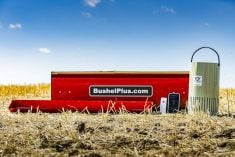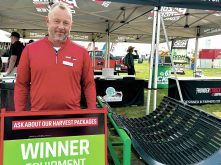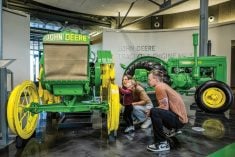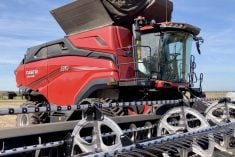For many farmers, pairing their favourite brand of combine with a header from a Prairie shortline manufacturer makes a preferred package.
Recently, though, some OEMs have denied header manufacturers the command set code needed to link the header with some combine and swather models’ digital systems — which means buyers of those machines will have to stick with a header from the OEM. Not all combines will be fully compatible with aftermarket headers.
“Economic theory would predict this (monopolistic) behaviour (by dominant companies),” says Carlo Dade, director for trade and trade infrastructure at the Canada West Foundation. “If you have the ability to return greater value to shareholders by locking down equipment and limiting choice, it’s simply rational (economic) behaviour.”
Read Also

Claas brings 1000 Series SP forage harvesters to Canada
In mid-August, Claas unveiled its new line of Jaguar forage harvesters at an event in Visalia, California, deep in the heart of that state’s dairy region.
Maximizing shareholder profits in this way, though, pits their interests against those of producers, by limiting purchase choices through anticompetitive means.
“It’s beginning to more and more resemble the tech industry,” says Anthony Rosborough, assistant professor of law and computer science at Dalhousie University. “We’re seeing these anti-competitive activities are transcending minor consumer inconveniences and creating deep competition and market unfairness.
“That increasingly now includes agricultural equipment.”
One of the shortline companies affected is Honey Bee Manufacturing. The southwestern Saskatchewan firm is starting to feel the impact of this trend.
“No one with a controller on the header right now is offering a technical package to allow third parties to put that same controller on a header or swather,” Honey Bee’s components, systems and integration manager Scott Smith says. “That can impact multiple brands.”
That lack of universal digital communication between machines and attachments is occurring even though there’s an ISOBUS standard protocol in place to facilitate it.
“The protocol is defined in ISOBUS. But the command set is not,” Smith says. “So when someone introduces that, when they’re a member of the ISOBUS community, as all OEMs are, they’re supposed to submit their command set to ISOBUS for ratification and inclusion in the published protocol. They refuse to do that. As such, they’re preventing us from participating on those platforms.”
The shortline brand can’t sell a header to mount on a particular combine if it doesn’t have the command set to electronically communicate with models that require it.
While it’s technically possible in many cases for engineers to reverse-engineer the command set code necessary to link a header to a combine’s digital system, that is actually illegal under Canadian copyright law.
What’s more, in accordance with the new Canada-U.S.-Mexico Agreement (CUSMA, or NAFTA 2.0), a company, or even a farmer doing it for personal use, can now be held both civilly and criminally liable for it.
“Canadian law prevents us from doing that legally,” Smith says. “That was upheld in a ruling, Nintendo vs. King, a few years ago. They got sued $13 million for their trouble.”
“The cost for the shortline is kind of a chilling effect, not being able to understand in certain cases the cost of liability,” Rosborough says. “We’re not talking about small potatoes in terms of liability for some of these companies.”
A recent lobbying effort by an industry group that included the Canada West Foundation resulted in Bill C-294, to amend the Copyright Act, being passed in the House of Commons last June — but it still awaits approval in the Senate, where it’s stalled at second reading.
“When we saw the X9 get locked down,” Dade says, “all the things we had been talking about as theoretical threats to the industry suddenly landed on our laps and prompted us to move more quickly with this.”

If and when it’s passed, C-294 will only be a foundation to modify other laws that fall under the jurisdiction of the provinces, who can then amend their agricultural machinery legislation to change the rules on digital access.
Dade says while the federal government quickly took steps to introduce C-294, he hasn’t heard much feedback from the provinces, who will need to play a key role.
But fixing the problem entirely may also require some changes to CUSMA, which is up for review in 2026.
The association representing shortliners, the Agricultural Manufacturers of Canada (AMC), has been lobbying on members’ behalf to bring this problem to the attention of governments and industry stakeholders.
It remains to be seen if producer associations will become vocal on this issue as well. There’s certainly a reason for them to be involved.
Along with the shortliners, producers will also feel the impact if the anti-competition trend continues — and not only in reduced equipment purchase options.
“Farmers buy mixed fleets,” Smith says. “They don’t buy all of one brand. There’s always some mix of equipment, and it’s always expected to work. As more and more technology comes onto the farm, the less brands are interoperable between themselves, the more that’ll be a challenge. And that’s really not helpful to anyone.
“I think the primary driver we’d like to see is some form of mandated interoperability for products sold in Canada. If that’s there, this problem goes away.”
















